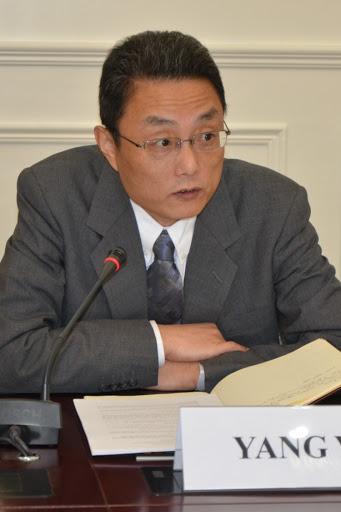
As the African proverb goes, when elephants fight, it is the grass that suffers. The intensifying China-US rivalry is putting mounting pressure on smaller countries, and Southeast Asian economies are no exception.
Continuous conflicts between Washington and Beijing over security, economic and trade issues and beyond have put mounting pressure on countries that have close economic relations with the two superpowers.
Former US president Donald Trump made a lot of noise about China and started a trade war that ended up hurting American consumers more than Chinese businesses. His successor has dialled down the rhetoric, but relations with Beijing remain tense.
President Joe Biden has warned Americans that China's prowess in areas such as technology will force America to raise its game if it does not want to be left behind. He has also made clear his desire to strengthen America's so-called Indo-Pacific strategy, raising its profile in Asia while deterring China's influence in the region.

"Undeniably, there are some blocks that need to be removed" in the regional relationship, says Yang Yi, secretary-general of the China Institute of International Studies in Beijing. SUPPLIED
Political and security analysts are thus urging the Asean community to come up with more action-oriented solutions, and to continue charting a careful path between the two major powers in order to benefit from both sides.
"The intensifying US-China agenda-setting, issue linkage and political constraints and inducements make us part of the vortex and force us to choose some options," said Evan Laksmana, senior researcher at the Center for Strategic and International Studies in Indonesia. "The extent to which we can respond is something we have to carefully look into in detail."
He made the comment during a recent webinar on the topic "Geoeconomic and Geopolitical Power Plays: The Major Powers and Southeast Asia", held by ISIS (Institute of Security and International Studies) Thailand. Mr Laksmana said Asean nations were increasingly finding themselves in a difficult position between the two major powers.
It is usual, even for officials at a working level, to be dragged into a conversation or agenda driven by officials of the two superpowers, for example on maritime security, he pointed out.
"In reality, the region cannot separate economic relations from the ongoing US-China competition, whether it is security, trade, technology, education -- all are linked and politicised for wider discussion, making it difficult for countries, for example Indonesia and other Asean neighbours, as our options are quite limited," said Mr Laksmana.

Asean nations do not want US constraints on China to turn into containment, says Cheng-Chwee Kuik, head of the Centre for Asian Studies at National University of Malaysia. Picasa
EXPANDING INFLUENCE
China has been seeking to expand its influence on many fronts, in Asia and beyond. The Belt and Road Initiative (BRI) has been a showcase programme, intended to connect Asia with Africa and Europe via land and maritime networks to improve regional integration, increase trade and stimulate economic growth.
Critics of the BRI have noted that many of its big-ticket projects have created financial dependence on China in the countries where they have been carried out.
Southeast Asian countries have been particularly exposed to China's expanding strategic influence and diplomacy in recent years, and that has made Asean a key focus for Washington. Indonesia, for example, despite having strong ties with the US and Australia in areas such as education and transport cooperation, has an economy that is still very much linked with China.
As a result, countries such as Indonesia are in a tricky position and can sometimes feel they are being forced to choose between interests in one area relative to others.
Both superpowers are using their instruments and leverage over regional countries to limit the options that smaller nations can hold on to, in the view of Mr Laksmana. The US, for example, might seek a country's support for sanctions against Russia, with the implicit message that it could be tied to other forms of cooperation.
China, meanwhile, has a much wider range of tools, especially given how dependent many Asean economies are on exports to the huge Chinese market.
Nevertheless, both big powers also provide inducements to negotiate issues that are important to the Asean community. As a result, governments of Asean nations have to find creative ways to respond to the US-China competition.

"Asean knows what to do and always will be pragmatic enough to cope with the issues at hand," says Kavi Chongkittavorn, a senior fellow of ISIS Thailand. SUPPLIED
"The US and China will continue competing with one another, pushing agendas and strategies and creating influence within the region. Our job is to respond in a much more coherent way at the domestic and international levels," said Mr Laksmana.
Australia could play a bigger role in helping Asean navigate the challenges it faces, says John Blaxland, a professor of international security and intelligence studies at the Australian National University.
He sees Australia as being in the unique position of ensuring that regional negotiations do not go awry. Not only does the country maintain good ties with the United States and -- until recently at least -- with China, but more importantly, it is a close neighbour to Asean.
Mr Blaxland was critical of the highly touted Foreign Policy White Paper released by Australia in 2017, which recommended keeping the US engaged in Asia, reaching out to like-minded countries including India, Indonesia and South Korea, and preventing coercive behaviour by major powers such as China and Russia. He sees the paper as flawed since it underplays the significance of Asean to Indo-Pacific strategy.
Australia has a shared ambition for regional stability, which has been shaken by tensions in the South China Sea. "It is important we do not poke the dragon, but pat the dragon," he said. "China is afraid of war and will avoid war. We do not kneel to the US either."

Intensifying US-China rivalry is making Asean "part of the vortex and forcing us to choose some options," says Evan Laksmana, senior researcher at the Center for Strategic and International Studies in Indonesia. Rahmad Gunawan
POSSIBLE COMMON GROUND
Yang Yi, secretary-general of the China Institute of International Studies in Beijing, said a China-US summit earlier this year in Alaska showed there was still room for cooperation, despite the posturing and rhetoric that marked the start of the two-day meeting. Both countries, he said, were able to find common ground to address and work together on climate change.
However, bilateral relations will be fraught with uncertainty as long as the US does not abandon its "cold war mentality", he said, adding that the major goal of the administration led by Xi Jinping is to create better lives for Chinese people.
Mr Yang said the recent deterioration in China-Australia relations had implications for the US alliance in the region. Beijing and Canberra have been at odds since Australia became the first country to ban the Chinese tech giant Huawei from its 5G network on security grounds, a contention Huawei continues to deny. That set a precedent for others, including the US, Japan, India, New Zealand and Singapore to follow.
Nevertheless, Mr Yang believes that all sides have a stake in ensuring good relations in the region.
"While having different cultures and history, we can find more areas of cooperation which can contribute to bilateral and regional cooperation," he said. "Undeniably, there are some blocks that need to be removed, and proper management is needed for bilateral relations, but the Asia Pacific relationship can benefit."
Kavi Chongkittavorn, a political analyst and senior fellow with ISIS Thailand, identified some other issues that will determine how Beijing and Washington will interact with Asean. They include Mekong sub-regional cooperation, the Myanmar crisis, and the fight against Covid-19 as well as the post-pandemic economic recovery process.
The Mekong is seen as a relatively new area of strategic competition for Washington. Over the past decade or so, the countries in the Mekong sub-region -- Myanmar, Thailand, Cambodia, Laos and Vietnam -- have benefited from China-supported development programmes.
But the impact of Chinese dam-building on the upper Mekong has also had consequences for downstream nations, and this is an area Washington has seized on to advocate for better environmental governance. It is backing programmes that support improved water governance and transparency in resource usage.
The Biden administration has also been overhauling US foreign policy and introducing more dynamic programmes. Its allies from Australia, New Zealand, Japan and South Korea are also being asked to help in more concrete ways to build up partnerships in the region.
When it comes to Covid, Asean can successfully find common ground in working with both superpowers on vaccines. The US has supported a temporary waiver of patent protection on Covid vaccines to keep costs down and encourage distribution in the developing world. China also provided Asean countries with millions of vaccine doses and other medical supplies.
Thailand, for example, is on track to receive some 6 million doses of Sinovac vaccine from China, including 1.5 million from donations and the rest via government-to-government purchases.
"If Asean has to choose between the US and China, Asean will choose its own side all the time because Asean knows what to do and always will be pragmatic enough to cope with the issues at hand, regardless of pressure being put on the regional community," Mr Kavi said, pointing to the handling of the political crisis in Myanmar as an good example.
Asean faced criticism for not doing enough in the immediate aftermath of the Feb 1 military coup in Myanmar. While Washington and the European Union pushed for more support for sanctions against the junta, Asean members signalled that they were in for the long haul.
They said they preferred a workable solution based on their deep knowledge of the region's dynamics and their consensus-driven decision-making process. Now the US, China and the rest of the international community is watching to see how this will play out.
Asean leaders invited Myanmar's military leader, Gen Min Aung Hlaing, to a special meeting last month in Jakarta, where all sides agreed to a five-point consensus on how to tackle the political crisis.
The leaders' resolution called for the immediate cessation of violence in Myanmar, constructive dialogue to seek a peaceful solution, and mediation to be facilitated by a special envoy who would visit Myanmar to meet all parties concerned.
Unfortunately, just days after Min Aung Hlaing returned home, he effectively turned his back on his neighbours. There will be no mediation, no visits by envoys, he said, until the famously inward-looking junta deems conditions in Myanmar to be stable. No one knows when that might be.

Australia's new foreign policy direction underplays the significance of Asean in Indo-Pacific strategy, says John Blaxland, professor of international security and intelligence studies at Australian National University. SUPPLIED
FUTURE PARTNERSHIPS
Mr Kavi also believes Asean could do more in reaching out to major powers for closer cooperation in other areas, however. He mentioned the Ayeyawady-Chao Phraya-Mekong Economic Cooperation Strategy (Acmecs) as a good middle way for engaging with US and international programmes. Consisting of Cambodia, Laos, Myanmar, Vietnam and Thailand, this regional framework is designed to bolster economic growth and reduce income disparity.
The Thai government in 2019 approved a proposal to contribute US$200 million (6.27 billion baht) as seed money to establish the Acmecs Fund for development projects in the region. Australia, Japan, South Korea and the US would contribute an additional $200 million and Myanmar, Laos, Cambodia and Vietnam a combined $100 million.
This new platform involving the US and its allies is similar to the Lancang-Mekong economic cooperation framework, launched in 2016 to strengthen development among countries along the Mekong River including China, Laos, Myanmar, Vietnam, Cambodia and Thailand. The Mekong group has developed its own identity which will dictate future engagement and outreach to major powers.
Meanwhile, the great power contest between the US and China will continue in Southeast Asia, manifested in the likes of US freedom-of-navigation operations in the contested South China Sea, or BRI projects led by China, said Cheng-Chwee Kuik, head of the Centre for Asian Studies at the Institute of Malaysian and International Studies at the National University of Malaysia.
While Asean countries will welcome some form of US involvement in the region to constrain China, they will not want constraints to shift to containment, he stressed. He believes that any attempt to contain China would only add to regional instability.
On the other hand, while Asean countries welcome the development that comes from the BRI, they will also be concerned about economic dependence on China and the security implications.
Ultimately, he believes that Asean countries will pursue policies of ambiguity to keep their distance between each superpower. Asean governments will want to be seen as not be taking sides in the ongoing rivalry.